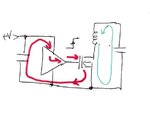konkot
Newbie level 2

Whenever i turn on my computer, the radio is being jammed
i known the reason is the switching power supply inside the computer
when it work, it emission the electromagnetic waves
My question is:
- What is the electronic component of the power supply make the emission
- If i use a power supply with higher capacity, is the emission decreased?
thanks a lot
i known the reason is the switching power supply inside the computer
when it work, it emission the electromagnetic waves
My question is:
- What is the electronic component of the power supply make the emission
- If i use a power supply with higher capacity, is the emission decreased?
thanks a lot






